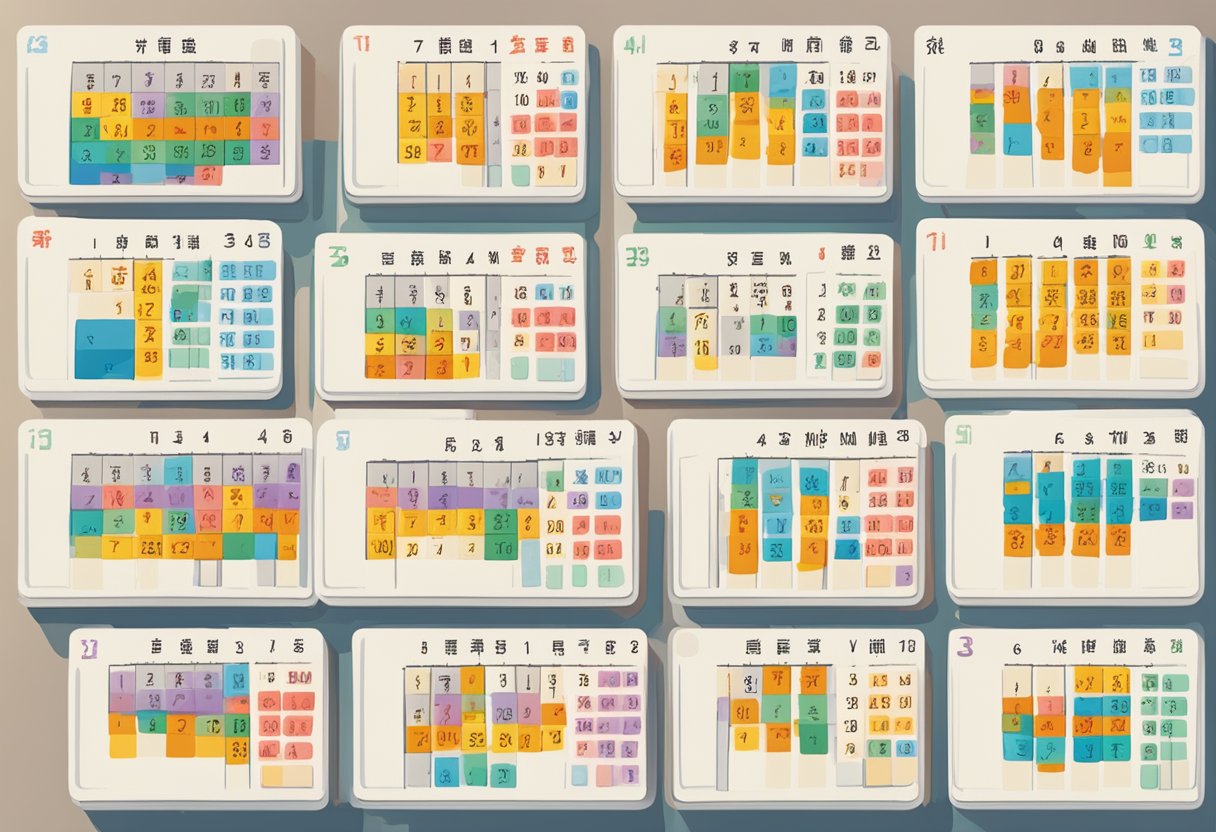How many Chinese characters should you learn per day? A realistic goal for language learners
Learning Chinese characters can seem daunting, but with the right approach, it's an achievable goal. Many language learners wonder how many characters they should tackle each day to make steady progress. A reasonable target is to learn 5-6 new Chinese characters per day, which would allow you to master around 2,000 characters in a year. This pace strikes a balance between making consistent progress and avoiding burnout.

The number of characters you learn daily can vary based on your current level, goals, and available study time. Beginners might start with 3-4 characters a day, while more advanced learners could aim for 10 or more. It's crucial to find a sustainable rhythm that works for you and allows for proper review and practice.
Remember that learning characters isn't just about memorisation. Understanding the parts of each character can help you grasp their meaning and make them easier to write. As you progress, you'll likely find that learning new characters becomes easier, allowing you to increase your daily target gradually.
Key Takeaways
- Set a realistic daily goal of 5-6 characters to maintain steady progress
- Adjust your target based on your level and available study time
- Focus on understanding character components to improve retention and writing skills
Getting Started with Characters
Learning Chinese characters can be exciting and rewarding. You'll discover fascinating linguistic patterns and cultural insights as you begin your journey. Let's explore the basics, character types, and some helpful tools to kickstart your learning.
Understanding the Basics
Chinese characters, or hanzi, are the building blocks of written Chinese. Each character represents a syllable and carries meaning. You'll start with simple characters like 人 (person) and 口 (mouth). These basic elements combine to form more complex characters.
Most characters follow logical patterns, making them easier to memorise once you grasp the underlying structure.
Radicals are another key concept. These component parts of characters often hint at meaning or pronunciation. For example, the water radical 氵 appears in words related to liquids.
Traditional Vs Simplified Characters
You'll encounter two main character sets: traditional and simplified. Traditional characters are older and more complex, used in Hong Kong and Taiwan. Simplified characters, introduced in mainland China, have fewer strokes and are easier to write.
Simplified characters are a good starting point for beginners. They're widely used and quicker to learn. However, knowing traditional characters can be beneficial if you're interested in classical literature or plan to visit Taiwan.
Some characters are identical in both systems, while others differ significantly. As you progress, you might choose to learn both or focus on the set most relevant to your goals.
Tools for Learning: Anki, Skritter and Mandarin Mosaic
Three popular tools can supercharge your character learning: Anki, Skritter and Mandarin Mosaic.
Anki is a free flashcard app that uses spaced repetition. You can create your own decks or download pre-made ones. It's brilliant for reviewing characters and their meanings regularly.
Skritter is a paid app designed specifically for Chinese characters. It teaches stroke order and tests your writing skills. The app uses handwriting recognition, making practice feel more natural.
Mandarin Mosaic is a Chinese learning app that takes a unique approach towards learning new words and characters using something called sentence mining. Using this method you'll study whole sentences instead of characters in isolation. This will help you better understand the meaning of new words, and prepare you to use them in context naturally.
These tools will allow you to reach your goals by teaching you thousands of characters. Aim for 10-20 new characters per day as a beginner. Consistency is key – regular practice with these apps can dramatically improve your character recognition.
Designing Your Learning Plan

Crafting an effective strategy is crucial for mastering Chinese characters. Your plan should balance ambition with consistency to achieve steady progress.
Setting Realistic Goals
How many characters can you tackle each day? It's tempting to aim high, but learning 10 characters per day is often more manageable than 30 or 40. Start small and adjust as you go.
Consider your current level and available time. Beginners might focus on 5-10 new words daily, while intermediate learners could target 10-15.
Remember, quality trumps quantity. It's better to thoroughly learn fewer characters than to skim through many. Pair each character with its pinyin and a common usage example.
Creating a Daily Routine
Set aside specific times for study, even if it's just 15-30 minutes twice a day.
Morning review: Go over yesterday's characters. Midday: Learn new characters. Evening: Practise writing and using them in context.
Use a spaced repetition system to reinforce your learning. Apps like Anki or Quizlet can help schedule reviews.
Mix it up! Combine character study with listening, speaking, and reading exercises. This approach helps cement the characters in your memory and improves overall language skills.
Mastering the Four Skills
Learning Chinese involves developing reading, writing, listening, and speaking abilities. These skills work together to enhance your overall language proficiency and communication.
Reading and Writing
To improve your reading skills, start with simple texts and gradually increase difficulty. Use flashcards or apps to practise character recognition.
In regards to writing, most people in today's age will not need to write characters by hand. Instead, focus on learning how to type characters using pinyin. Practise typing characters regularly, even if it's just a few minutes daily. This helps reinforce your memory.
Expand your vocabulary by learning common words and phrases. Pay attention to how characters combine to form new meanings. This will boost both your reading and writing abilities.
Listening and Speaking
To enhance your listening skills, immerse yourself in Chinese audio content. Listen to podcasts, watch Chinese films, or tune into radio programmes. Start with slower-paced materials and work your way up to native-speed content.
For speaking, focus on proper pronunciation and tones. Practise with a language partner or tutor to get immediate feedback. Don't be afraid to make mistakes – they're part of the learning process.
Work on your grammar by constructing simple sentences and gradually increasing complexity. Memorise useful phrases for everyday situations to boost your confidence in real-life conversations.
Remember, consistency is key. Practise all four skills regularly to see steady improvement in your Chinese language abilities.
Overcoming Challenges
Learning Chinese characters can be daunting, but with the right strategies, you can overcome common hurdles. Effective memory techniques and staying motivated during plateaus are key to steady progress.
Using Mnemonics for Memory
Mnemonics are powerful tools for remembering Chinese characters. Create vivid mental images that link the character's shape to its meaning. For instance, picture a person (人) standing next to a tree (木) to remember the character 休 (rest).
Break complex characters into familiar components. The character 想 (to think) combines 相 (mutual) and 心 (heart). Imagine two hearts thinking together.
Try associating characters with English words that sound similar. The character 猫 (cat) sounds like "maow" - picture a cat meowing.
Flashcards with mnemonics on the back can boost your recall. Mix this technique with writing practice for best results.
Dealing with Plateaus
Hitting a plateau is normal when learning Chinese. Don't get discouraged - it's a sign you're ready for new challenges.
Shake up your routine. If you've been focusing on reading, spend more time on writing or speaking. This helps reinforce characters from different angles.
Review previously learned characters regularly. Use spaced repetition apps to keep old vocabulary fresh while learning new ones.
Try teaching someone else what you've learned. Explaining characters to others solidifies your own understanding.
Remember, fluency is a journey. Celebrate small victories and keep pushing forward. Your hard work will pay off in the long run.
Frequently Asked Questions

Mastering Chinese characters takes time and consistent effort. The number you should learn daily depends on your goals and learning style.
What's the average number of Chinese characters a person needs to learn to be considered fluent?
To be considered fluent in Chinese, you'll need to know about 2,000 characters. This level allows you to read most everyday materials and engage in meaningful conversations.
How long does it normally take to master a thousand Chinese characters?
Learning 1,000 characters typically takes about a year of dedicated study. If you aim to learn 5-6 characters per day, you can reach this milestone in less than 12 months.
Should I cram loads of Chinese characters daily or take it slow and steady?
It's best to take a steady approach. Learning too fast can lead to burnout and demotivation.
Do I need to know as many characters in Chinese as a native speaker to be properly fluent?
No, you don't need to match a native speaker's character knowledge. Knowing about 2,000-3,000 characters will enable you to communicate effectively in most situations.
How much time should I dedicate to studying Chinese each day to make decent progress?
Aim for 1-2 hours of focused study daily. Consistency is key, so it's better to study for shorter periods every day rather than long sessions less frequently.